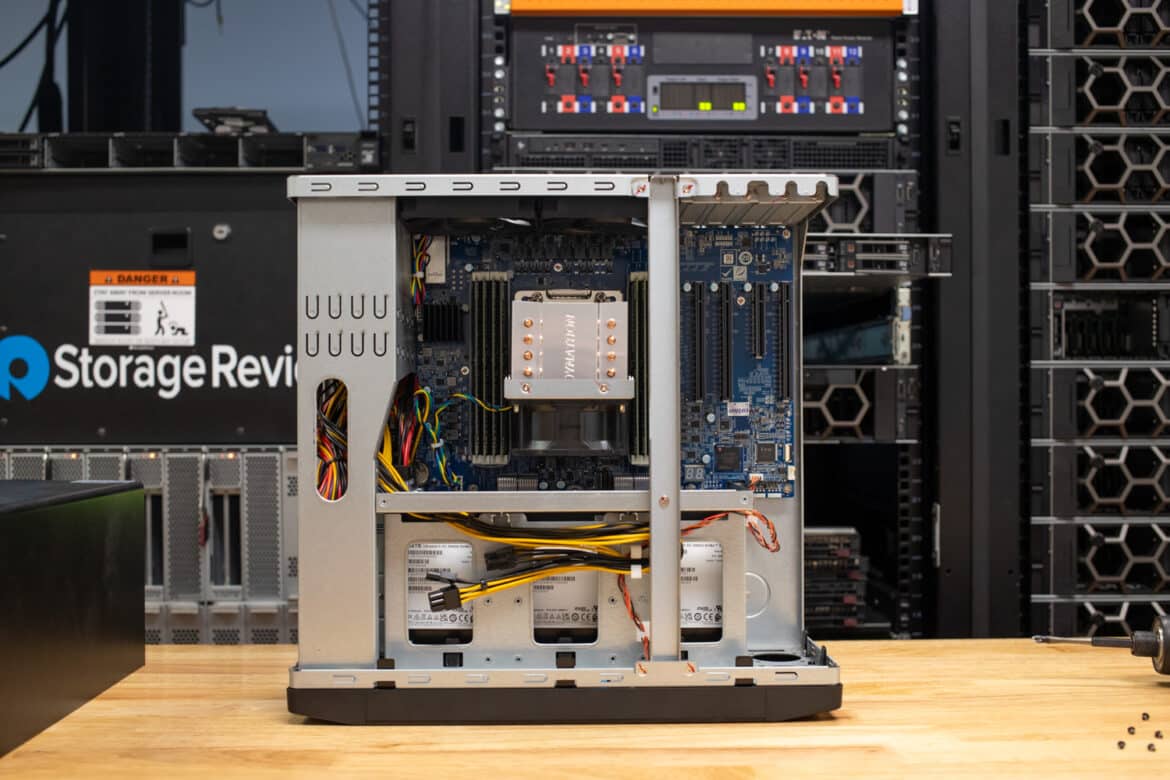The QNAP TS-h1290FX is a 12-bay, all-flash NVMe NAS powered by an AMD EPYC CPU and bringing impressive performance with 25GbE.
The QNAP TS-h1290FX is a robust 12-bay U.2 NVMe/SATA all-flash NAS, targeting environments where high-speed data access and processing, along with a small footprint, are most important to organizations. It is designed to cater to office or on-set environments, offering a powerful solution for collaborative 4K/8K video editing and extensive file-sharing needs. The NAS also boasts a range of useful features, including 25GbE connectivity, GPU support, and a ZFS-based storage system, aimed at delivering both performance and data integrity.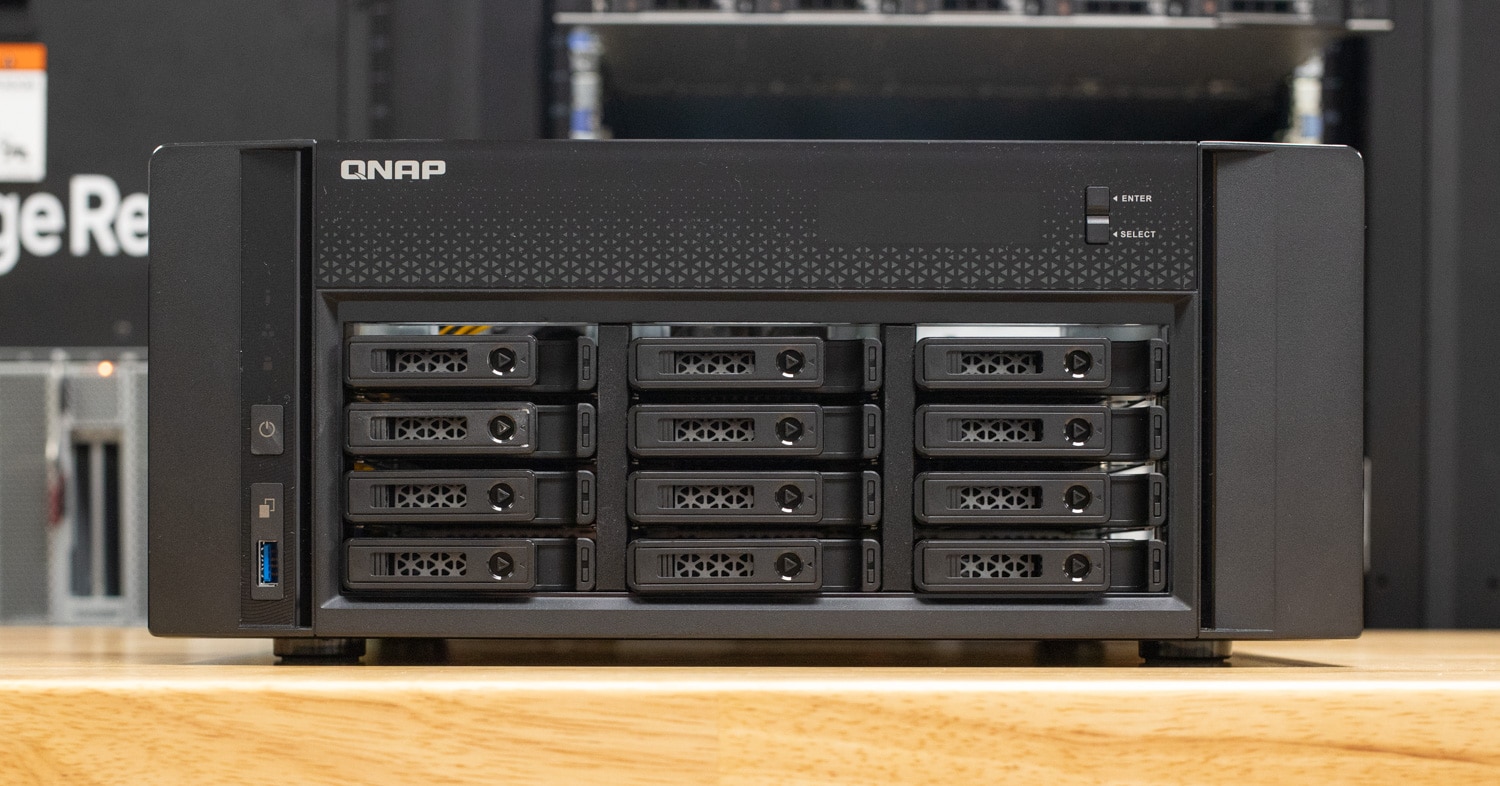
The TS-h1290FX is powered by an AMD EPYC 7302P or 7232P processor (depending on the model), which is part of the 2nd Gen AMD EPYC 7002 series known for its “Zen 2” architecture and 7nm process technology. Moreover, its supported DDR4 ECC RDIMM memory is expandable up to 1TB across 8 DIMMs, allowing the TS-h1290FX to handle memory-intensive tasks while ensuring data reliability through error correction. The NAS is also designed to grow with businesses, as you can connect it to the TR-002, TR-004, TL-D800C, and TL-D800S expansion enclosures to hit petabytes of storage.
QNAP also highlights pretty solid potential performance for the TS-h1290FX. With six 25GbE iSCSI connections, they claim it can deliver up to 816,051 IOPS for downloads and 318,011 IOPS for uploads. Similarly, its 6 x 25GbE SAMBA sequential throughput is noted as 14,208MB/s for downloads and 8,583 MB/s for uploads. As always, the quoted speeds are often under optimal conditions (and more ports), we will be testing as-shipped, with only our own batch of 15.36TB WD SN655 enterprise SSDs.
QNAP TS-h1290FX Design, Build and Connectivity
In terms of design and user experience, the TS-h1290FX emphasizes a quiet operational environment. It features a CPU cooler and two 90mm near-silent system fans to ensure effective cooling without intrusive noise—crucial for creative and office spaces where people may work near this unit. With noise levels under 35dBA in normal mode, it promises to maintain a quiet work environment.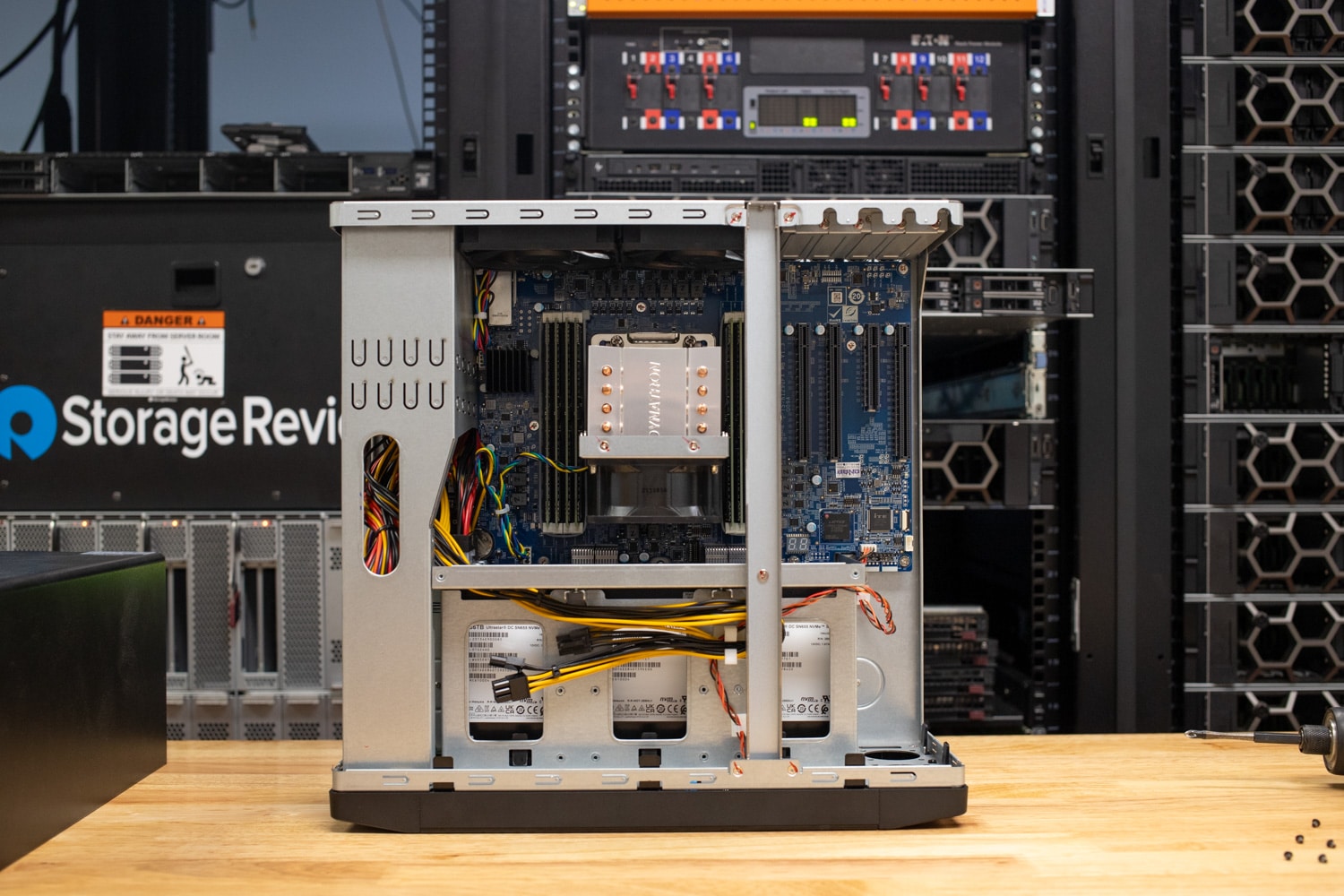
Thanks to its dual 25GbE SFP28 ports and two 2.5GbE RJ45 ports, the TS-h1290FX provides direct connectivity for up to 20 PCs/workstations without requiring a switch. This feature, combined with the ability to install various PCIe Gen4 expansion cards, enhances the NAS’s adaptability to different work environments and needs. Moreover, its compatibility with popular video editing software like Adobe Premiere Pro and Final Cut Pro X makes it a viable option for professional video editing teams.
Further connectivity on the TS-h1290FX includes a USB 3.2 Gen 1 port on the front panel, located to the left of the stacked 3×4 2.5-inch U.2 NVMe/SATA 6Gbps SSD bays, while the other two ports reside on the rear. The four PCIe Gen4 slots are also located on the back panel.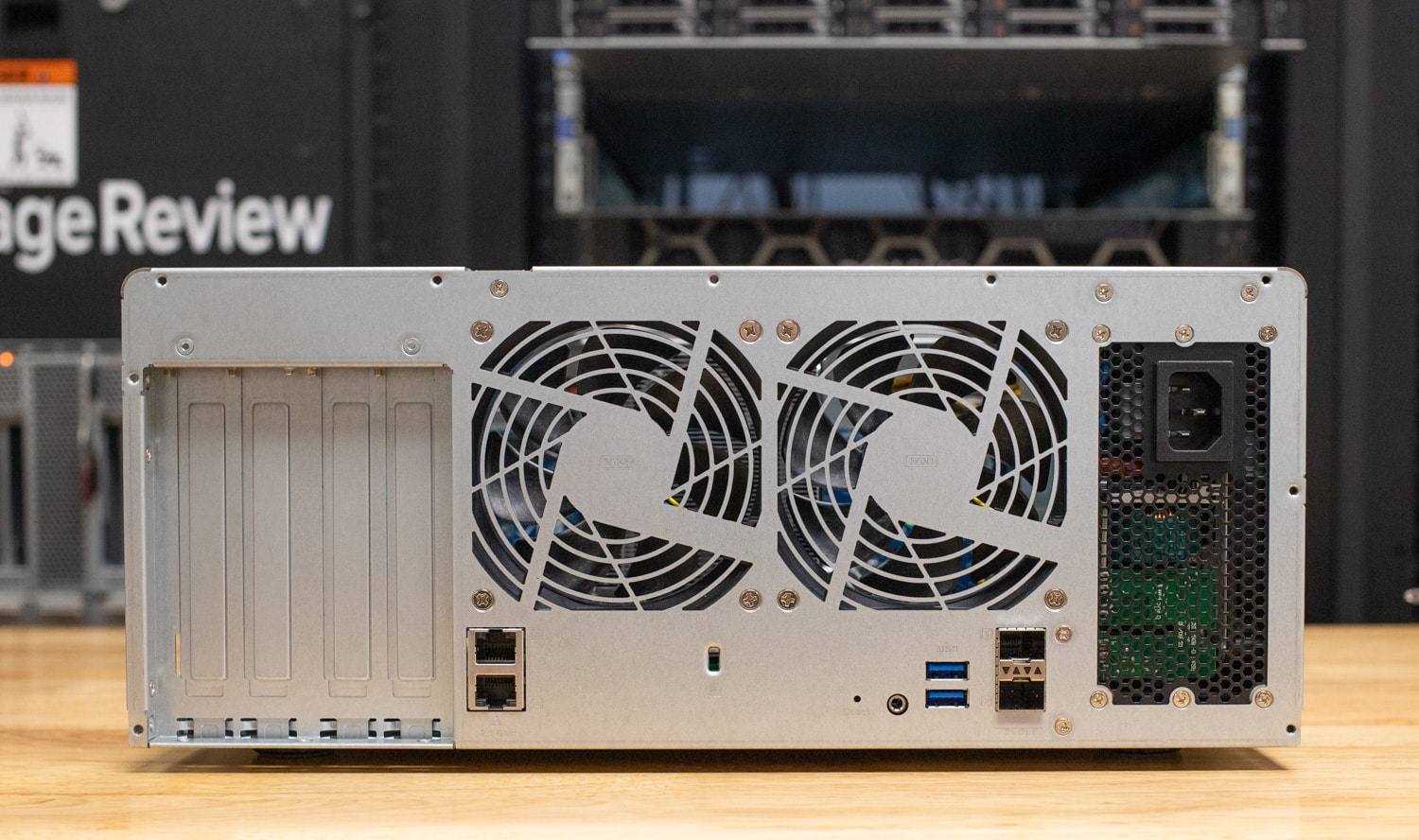
As for the build itself, the QNAP TS-h1290FX boasts a sleek and sturdy all-metal build. With dimensions measuring approximately 14.25 inches in depth, 14.49 inches in length, and 6.19 inches in height, this will be a compact and stylish addition to any organization’s network storage ecosystem.
QNAP TS-h1290FX Backup Capabilities
The TS-h1290FX extends its utility with comprehensive backup and disaster recovery solutions, supporting a comprehensive range of applications designed to make regular backup habits seamless and effective. With tools like Hybrid Backup Sync, users can easily back up data from the TS-h1290FX to another QNAP NAS or a remote server, which aligns with the 3-2-1 backup strategy–three copies of your data (one primary and two backups), stored on two different types of media, one of which is stored off-site.
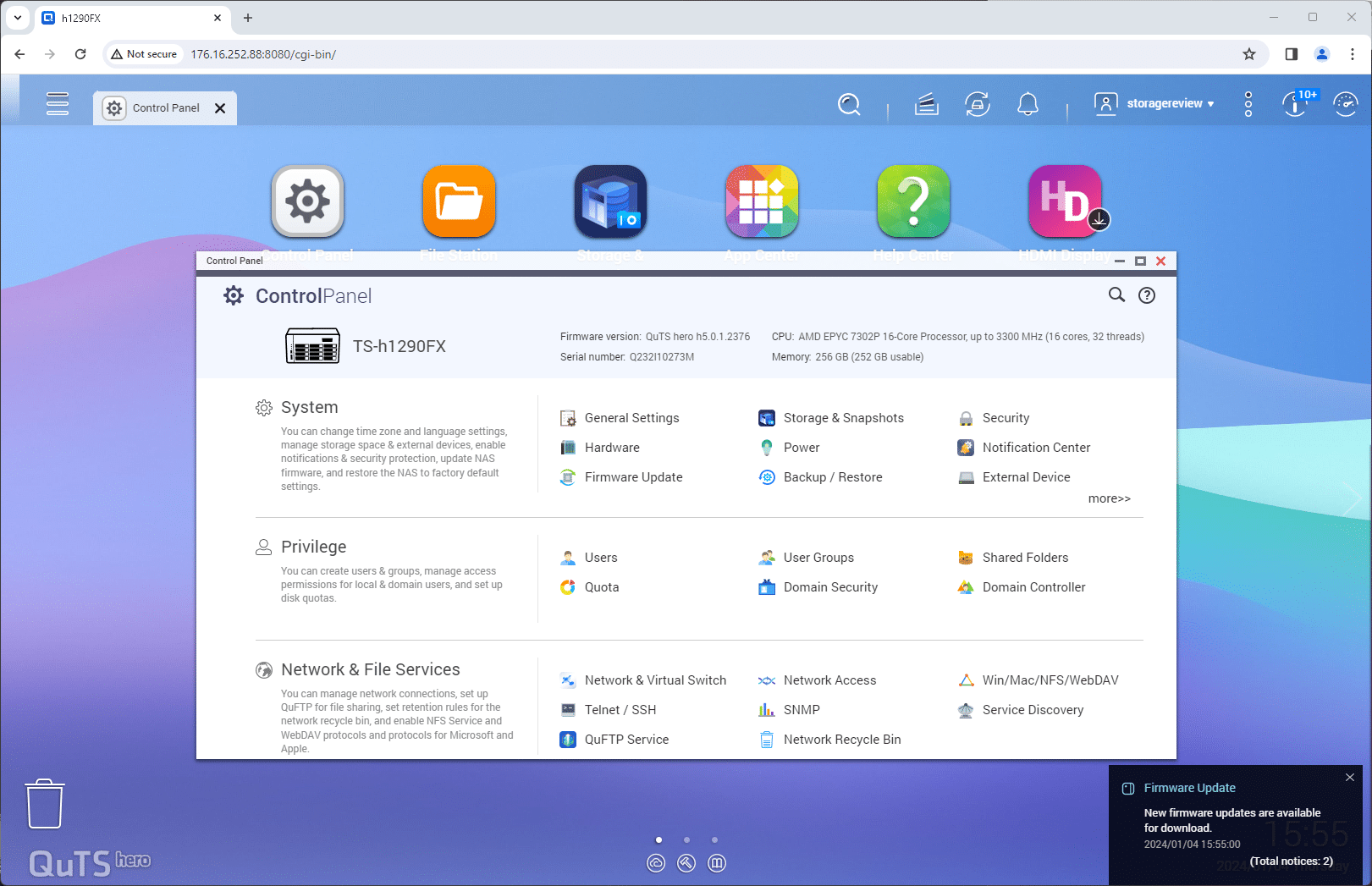
Additionally, it offers license-free VM backup for VMware and Hyper-V with features like source-side incremental backup, global deduplication, and recovery compression. For businesses relying on Cloud services, the NAS provides SaaS backup options to protect data from platforms like Google Workspace and Microsoft Office 365. Moreover, its support for mainstream Cloud storage services and QuDedup technology efficiently eliminates redundant data at the source, which helps reduce both storage costs and backup time. The inclusion of Real-time SnapSync and multi-version snapshots further strengthens its defense against threats like ransomware, ensuring that data can be restored to a specific point in time if needed.
QNAP TS-h1290FX Pricing and Warranty
Backed by a 5-year warranty, our review unit is the QNAP TS-h1290FX-7302P-256G-US, which is priced at $8,400. Unique to this model is the AMD EPYC 7302P 16-core processor (reaching speeds up to 3.2GHz) and 256GB of ECC DDR4 RAM across 8 RDIMM slots.
The TS-h1290FX-7232P-64G and TS-h1290FX-7302P-128G models feature 64GB and 128GB of DDR4 RAM, respectively, and are priced at $4,900 and $7,000. At the time of this review, Amazon (affiliate link) has the 64GB model for sale at $5410, B&H has models under $5K.
QNAP TS-h1290FX Specifications
As previously mentioned, our review unit is the QNAP TS-h1290FX-7302P-256G-US, containing the AMD EPYC 7302P (16C/32T), 128GB DDR4, and no drives.
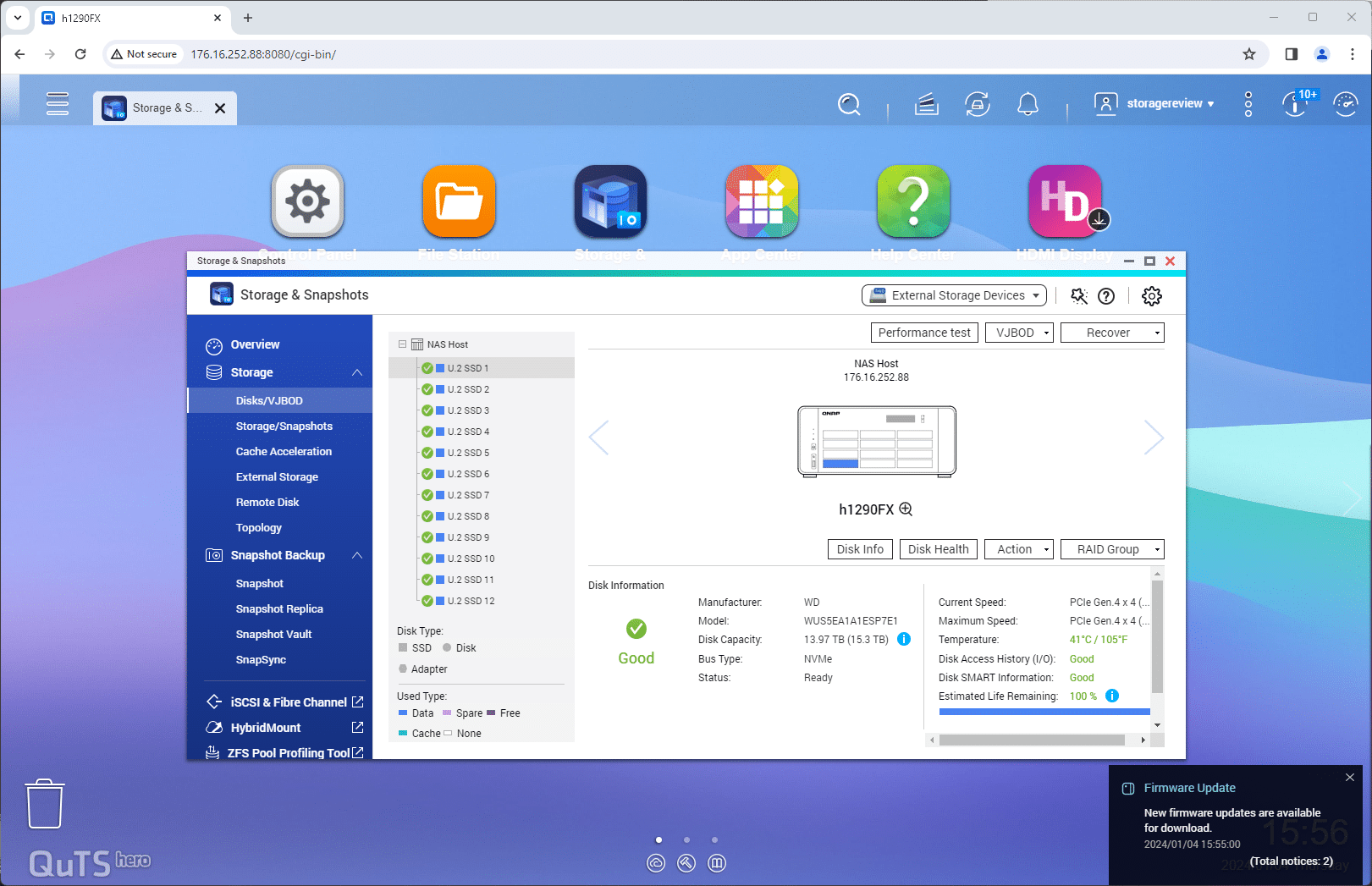
The other Configuration options for the h1290FX are as follows.
| TS-h1290FX-7232P-64G | TS-h1290FX-7302P-128G | TS-h1290FX-7302P-256G | ||
| CPU | AMD EPYC 7232P 8-core/16-thread processor, up to 3.2 GHz | AMD EPYC 7302P 16-core/32-thread processor, up to 3.3 GHz | ||
| CPU Architecture | 64-bit x86 | |||
| Encryption Engine | (AES-NI) | (AES-NI) | (AES-NI) | |
| System Memory | 64 GB RDIMM DDR4 ECC (8 x 8 GB) | 128 GB RDIMM DDR4 ECC (8 x 16 GB) | 256 GB RDIMM DDR4 ECC (8 x 32 GB) | |
| Maximum Memory | 1 TB (8 x 128 GB) | |||
| Memory Slot | 8 x RDIMM DDR4 | |||
| Flash Memory | 5GB (Dual boot OS protection) | |||
| Drive Bay | 12 x 2.5-inch (system is shipped without SSDs) | |||
| Drive Compatibility | 2.5-inch bays:
|
|||
| Hot-swappable | Yes | Yes | Yes | |
| SSD Cache Acceleration Support | Yes | Yes | Yes | |
| GPU pass-through | Yes | Yes | Yes | |
| SR-IOV | Yes | Yes | Yes | |
| 2.5 Gigabit Ethernet Port (2.5G/1G/100M) | 2 (also support 10M) | |||
| 25 Gigabit Ethernet Port | 2 x 25GbE SFP28 SmartNIC port | |||
| Wake on LAN (WOL) | Only the 2.5GbE port | Only the 2.5GbE port | Only the 2.5GbE port | |
| Jumbo Frame | Yes | Yes | Yes | |
| PCIe Slot | 4
|
|||
| USB 3.2 Gen 1 port | 3 | |||
| Form Factor | Tower | |||
| LED Indicators | Power/Status, LAN, USB, SSD1-12 | |||
| LCD Display/ Button | Yes | Yes | Yes | |
| Buttons | Power, Reset, USB Auto Copy | |||
| Dimensions (HxWxD) | 150 × 368 × 362 mm | 157.2 × 368 × 362 mm | ||
| Weight (Net) | 8.99 kg | |||
| Operating temperature | 0 – 404°C (324°F – 104°F) | |||
| Storage Temperature | -20 – 704°C (-44°F – 1584°F) | |||
| Relative Humidity | 5-95% RH non-condensing, wet bulb: 274°C (80.64°F) | |||
| Power Supply Unit | 750W, 100-240V | |||
| Fan | 2 x 92mm, 12VDC | |||
| System Warning | Buzzer | |||
| Kensington Security Slot | Yes | Yes | Yes | |
| Max. Number of Concurrent Connections (CIFS) – with Max. Memory | 10,000 | |||
QNAP TS-h1290FX Performance
For this review, we loaded the TS-H1290FX with 12 x 15.36TB WD SN655 SSDs (which are on the HCL), configured in RAID5. We used the onboard dual-port 25GbE NIC to connect it to our lab network. The Ethernet switch used is a Dell Z9100 100GbE capable switch. For our client, a Dell PowerEdge R740xd running Windows Server 2022 was leveraged, running Fio as our I/O loadgen.
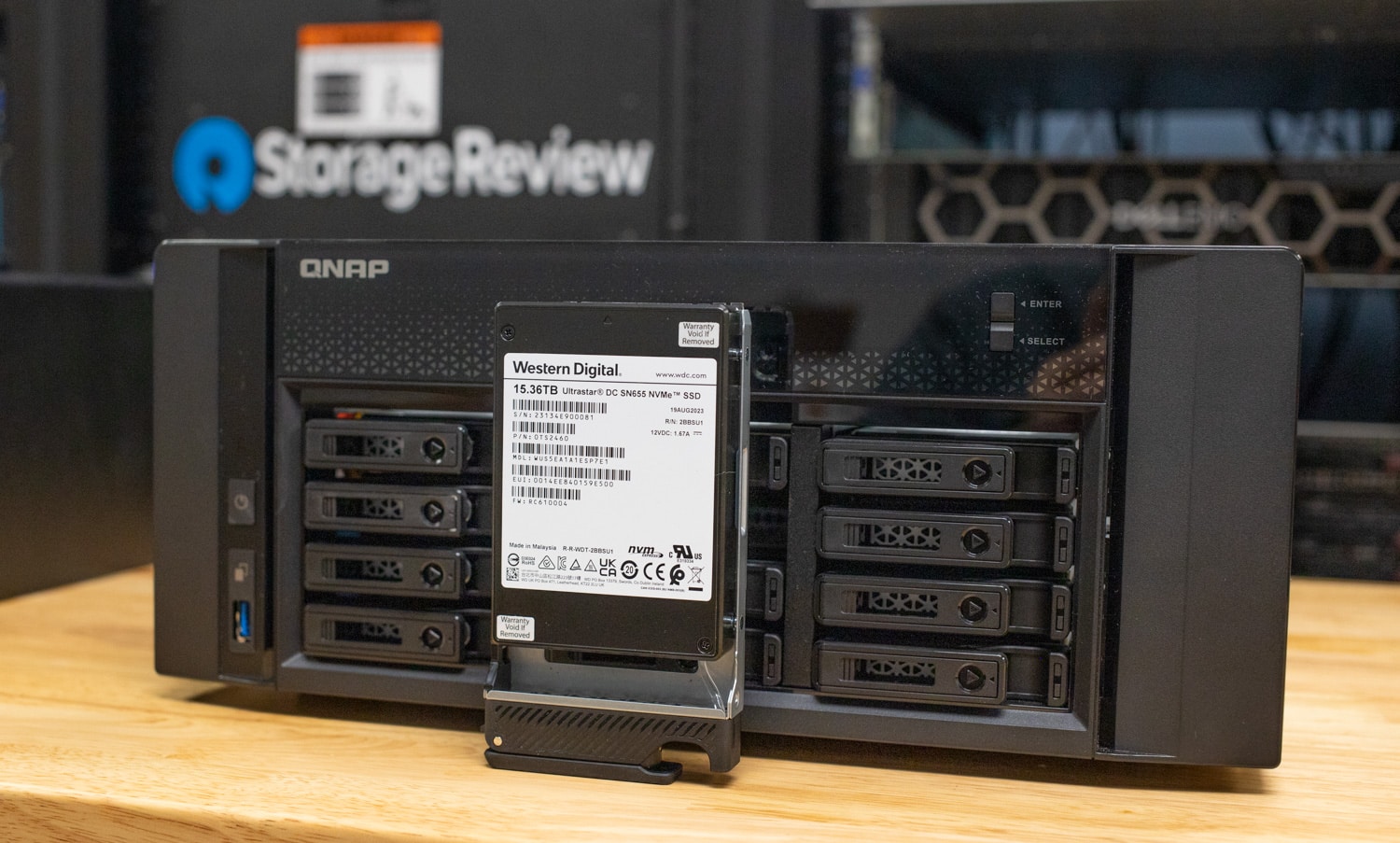
Our enterprise NAS testing process preconditions each drive-set into steady-state with the same workload the device will be tested with under a heavy load of 16 threads, with an outstanding queue of 16 per thread. The device is then tested in set intervals in multiple thread/queue depth profiles to show performance under light and heavy usage. Since hard drives reach their rated performance level very quickly, we only graph out the main sections of each test.
Preconditioning and Primary Steady-State Tests:
- Throughput (Read+Write IOPS Aggregate)
- Average Latency (Read+Write Latency Averaged Together)
- Max Latency (Peak Read or Write Latency)
- Latency Standard Deviation (Read+Write Standard Deviation Averaged Together)
Our Enterprise Synthetic Workload Analysis includes three profiles based on common workload sizes. These profiles have been developed to make it easier to compare to our past benchmarks, as well as widely-published values such as max 4K read and write speed and 8K 70/30, which is commonly used for storage devices. When testing NAS platforms, for each storage pool we benchmark, we provision four shared folders for 25GB files and four 25GB iSCSI luns.
4K
- 100% Read or 100% Write
- 100% 4K
8K 70/30
- 70% Read, 30% Write
- 100% 8K
128K (Sequential)
- 100% Read or 100% Write
- 100% 128K
Note: In our testing of the QNAP TS-H1290FX, we will compare the speeds of RAID5 SMB and RAID5 ISCSI to the speeds of RAID5 SMB and RAID5 ISCSI with Data Reduction, notated by the DR on the charts.
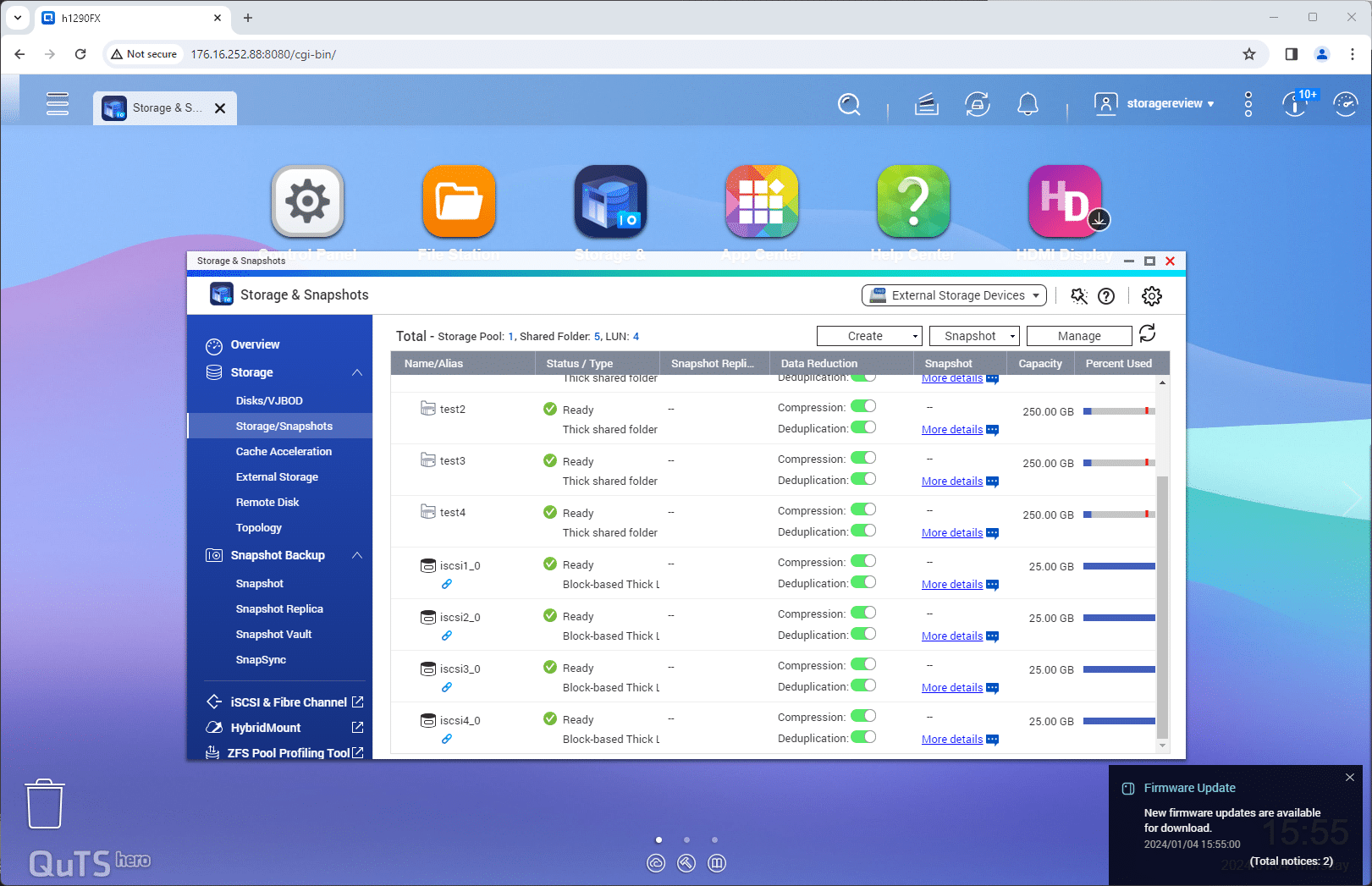
4K Throughput
Our first throughput test in the enterprise workload measures 4K random performance of the QNAP TS-H1290FX. Here you can see the speeds between SMB and ISCSI were vastly different, but interestingly with a slight performance reduction on SMB with Data Reduction, bringing it down by roughly 6k IOps on read, and 32k IOPS on write. On ISCSI with Data reduction, we see noticeable speed increases, by almost 68k IOPS on read, but interestingly a reduction by about 26k IOPS on write.
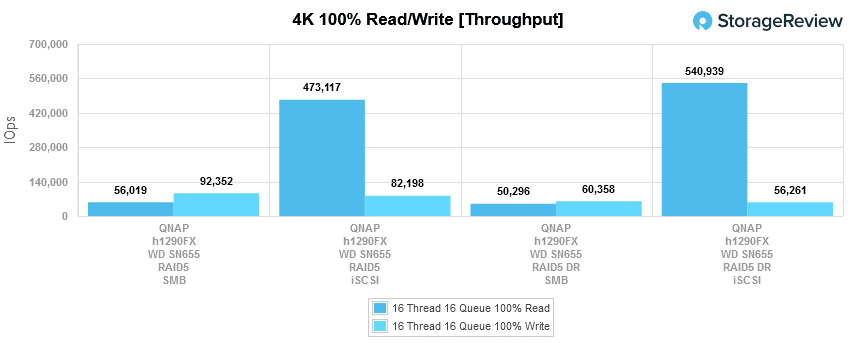
4K Average Latency
In average latency, the TS-H1290FX showed read and writes of only 4.57ms and 2.77ms SMB, and 0.54ms read and 3.11ms write on ISCSI. With Data Reduction, we see a similar pattern to what happened on throughput where SMB with DR is slower, but ISCSI with DR is faster on read but slower on write. The differences were close but on SMB with DR, read was only up by 0.52ms, and write was up by 1.47ms with ISCSI being down by only 0.07ms on read but up by 1.44ms on write.
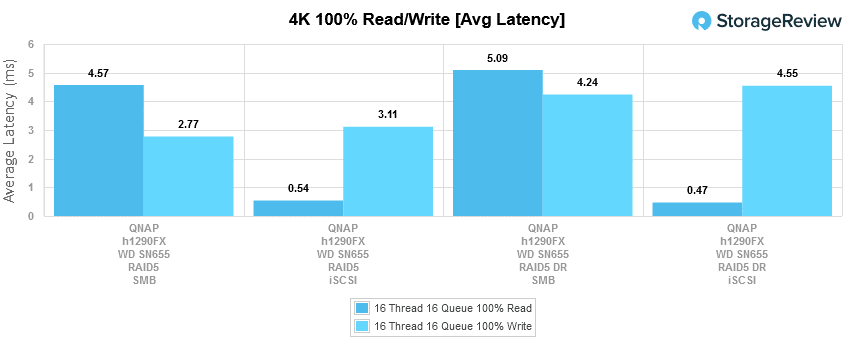
4K Max Latency
Next up is max latency. The TS-H1290FX showed better on SMB than ISCSI, and slower all around on both tests with Data Reduction. The read speeds were all pretty similar but the real differences came with the write speed. The highest latency change came between ISCSI and ISCSI with DR, with a 143.9ms increase with DR.
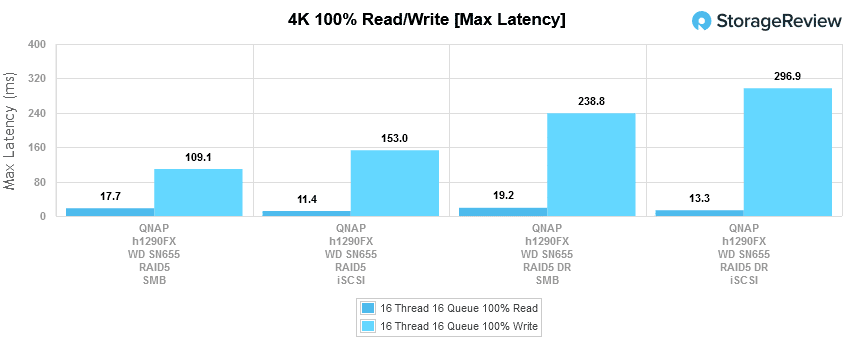
4K Standard Deviation
For standard deviation, the TS-H1290FX brought 1.91ms read and 6.16ms write in SMB, and 0.26ms read and 7.18ms write in ISCSI. With Data Reduction, we saw 2.15ms read and 6.49ms write on SMB and 0.16ms read and 11.76ms write on ISCSI.
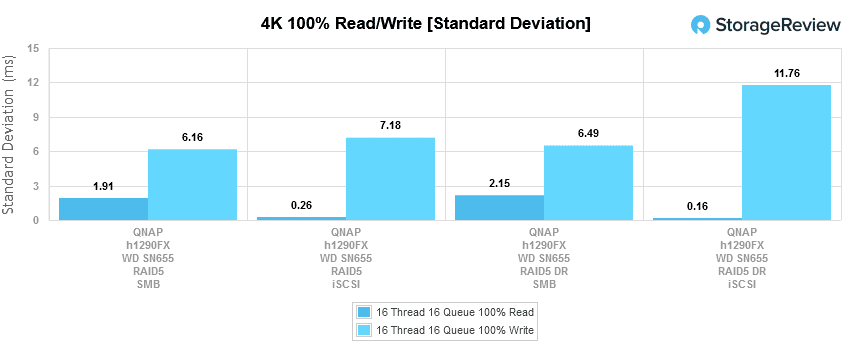
8K 100% Read/Write
Our next benchmark puts the drives to 100% read and write activity with 8K sequential throughput. In this test the TS-h1290FX reached 53,131 IOps read and 344,307 IOps write on SMB, with 438,020 IOPS Read and 272,830 IOPS Write on ISCSI. With Data Reduction, we saw 51,714 IOps read and 280,606 IOps write on SMB, with 433,412 IOps read, and 259,739 IOps write on ISCSI.
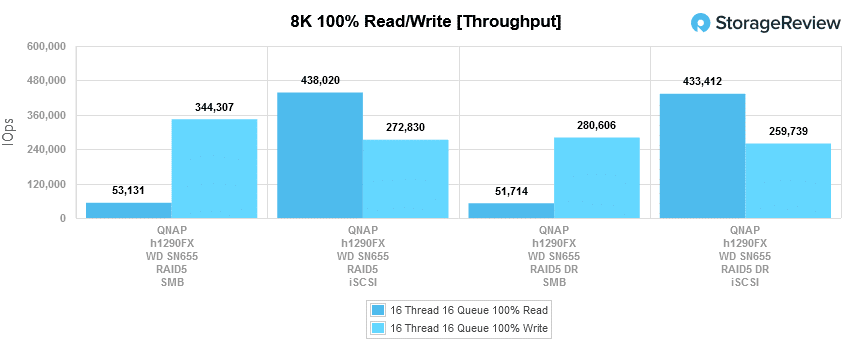
8k 70/30 Throughput
Our next test shifts from a pure 8K sequential 100% read/write scenario to a mixed 8K 70/30 workload to demonstrate how performance scales in a setting from 2T/2Q up to 16T/16Q. In throughput, the TS-h1290FX brought a range from 27,544 IOps to 198,448 IOps in SMB, and from 28,027 IOps to 220,454 IOps in ISCSI. With Data Reduction, we saw a range from 47,441 IOps to 152,425 IOPS on SMB and 24,139 IOps to 161,543 IOps on ISCSI.
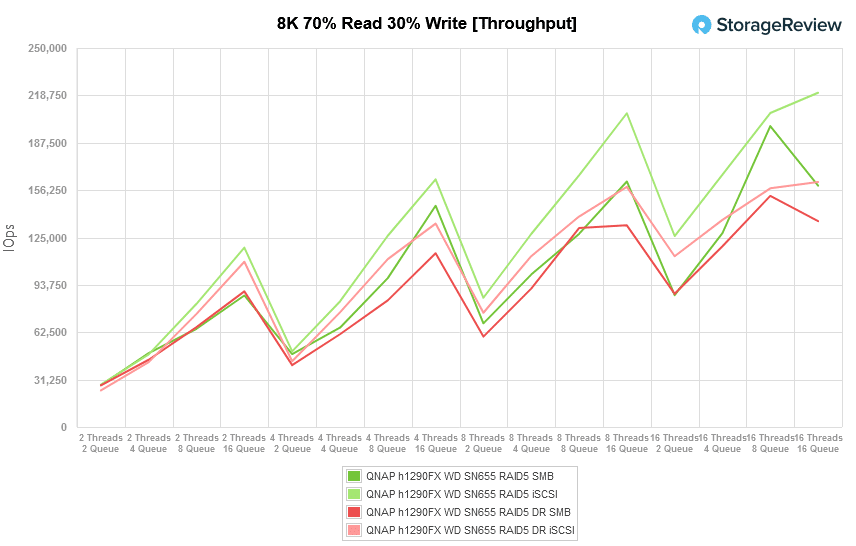
8k 70/30 Average Latency
For average latency on the TS-h1290FX, we saw very good results being an all-flash configuration. We saw from 0.14ms to 1.6ms on SMB, and 0.14ms to 1.15ms on ISCSI. With Data Reduction, we saw from 0.14ms to 1.88ms on SMB, and 0.16ms to 1.58ms on ISCSI.
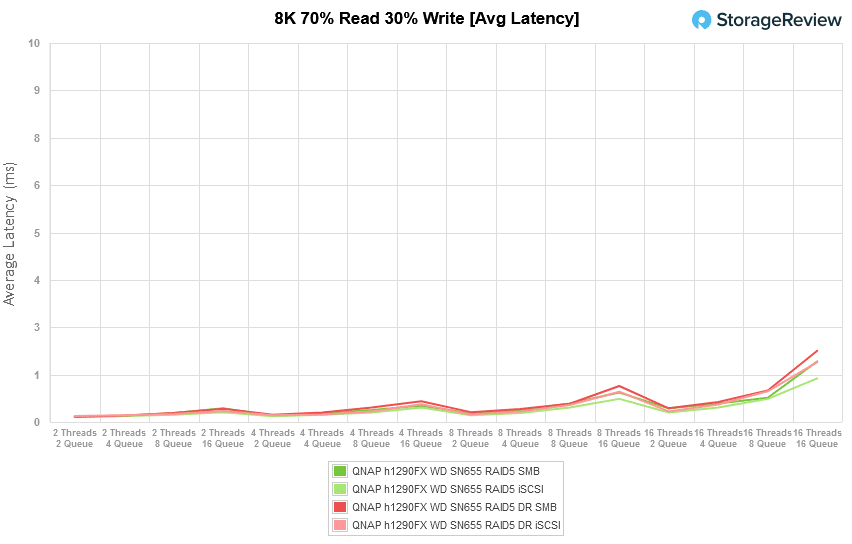
8k 70/30 Max Latency
In the maximum latency test, the TS-h1290FX showed its best performance in ISCSI without Data Reduction. We saw 14.9ms to 489.43ms on SMB, and 41.05ms to 102.7ms on ISCSI. With Data Reduction, we saw from 40.82ms to 421.46ms SMB, and 127.41ms to 277.74ms on ISCSI.
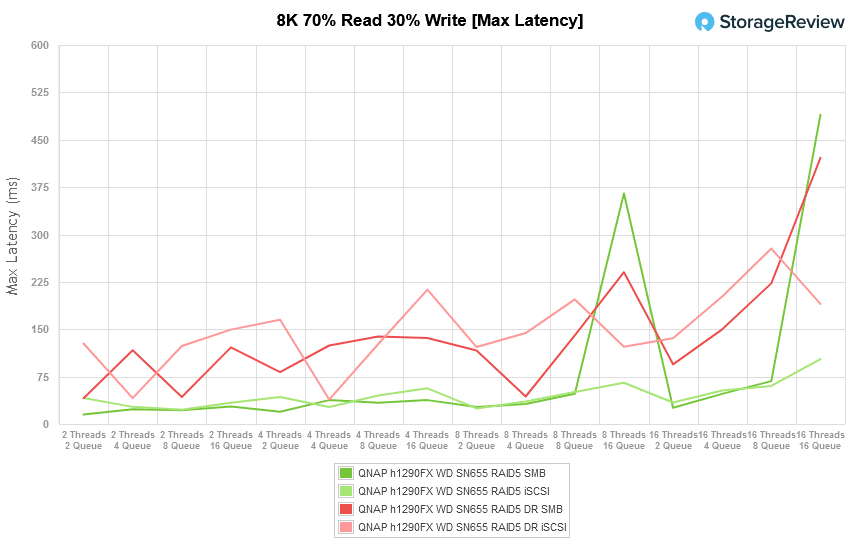
8k 70/30 Standard Deviation
For Standard Deviation Latency, the TS-h1290FX performed very well on all four setups. Here we saw 0.09ms to 2.49ms on SMB, and 0.11ms to 2.23ms on ISCSI. With Data Reduction, we saw 0.14ms to 4.07ms on SMB, and 0.15ms to 4.49ms on ISCSI.
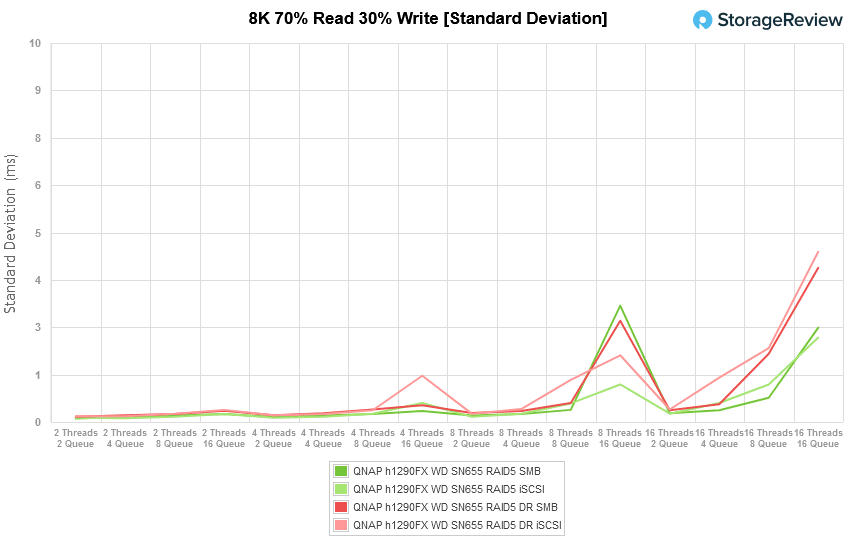
128k 100% Read/Write Throughput
For our final test, we have the 128k benchmark. This test is a large block sequential test showing the highest sequential transfer speed. For SMB we saw 2.58GB/s Read and 1.04GB/s Write, whereas ISCSI showed 1.6GB/s Read and 3.5GB/s Write. With Data Reduction, we saw 4.16GB/s Read and 1.21 GB/s Write on SMB, and 1.6GB/s Read and 3.4GB/s Write on ISCSI.
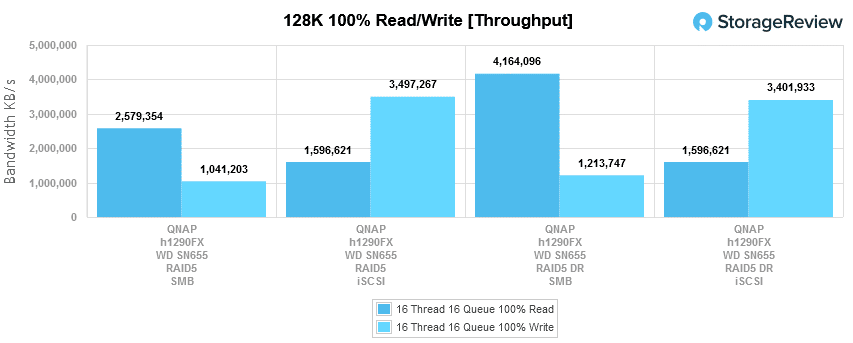
Conclusion
The QNAP TS-h1290FX stands out as a high-capacity, high-speed NAS tailored for demanding tasks like intensive video editing and large-scale file sharing. Powered by advanced AMD EPYC processors and supporting up to 1TB of memory, the H1290FX offers robust performance and expansion options. Its design prioritizes quiet operation and diverse connectivity, including multiple 25GbE ports onboard, making it an adaptable and discreet addition to any professional environment.
The capabilities storage-wise showed themselves in our testing when paired with WD SN655 NVMe drives. The latency results were very low with sub-millisecond readings for most of the average latency and standard deviation on the 70/30 tests. Throughput-wise, we also saw results upwards of 4.16 GB/s read on SMB with Data Reduction. These are results you would expect from an all-flash setup but are still good to see.
With the pretty aggressive hardware build, the h1290FX could have some interesting use cases when adding a GPU. The addition of GPUs could help with passthrough to locally hosted VMs allowing it to step outside the tracks of a conventional NAS and bring more server-like functions onboard all in a desktop package.
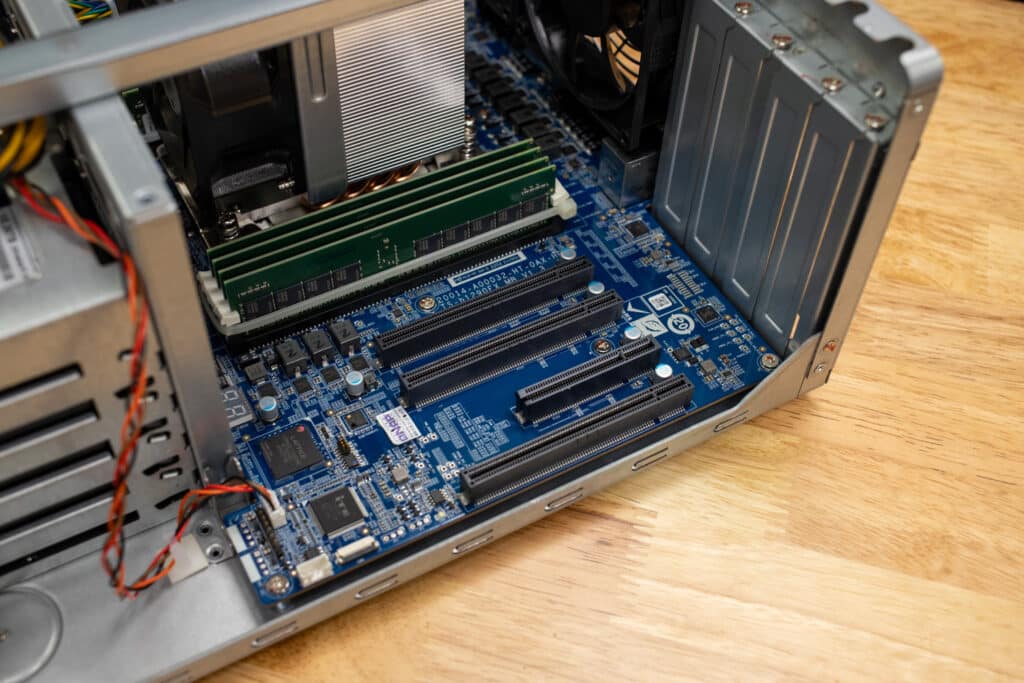
Overall, the QNAP TS-h1290FX all-flash NAS presents itself as a powerful, scalable solution for data-intensive environments. The NAS is also pretty portable, considering we have nearly 150TB of usable RAID5 storage in this box with 15.36TB SSDs, it’s easy to see why this would be a popular solution for a host of use cases like on-site professional media and entertainment workloads. Argue all you will about this category of “packaged NAS” solutions and how this is more expensive than rolling your own ZFS storage, but this design and ease of use from QNAP are pretty great and the TS-h1290FX is one we intend to explore much further in our lab. We’re big fans and find this to be the first “Best Of” winner for 2024.

Product page for the QNAP TS-h1290FX.
Engage with StorageReview
Newsletter | YouTube | Podcast iTunes/Spotify | Instagram | Twitter | TikTok | RSS Feed

